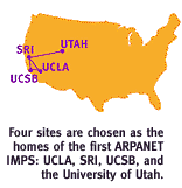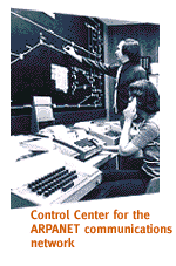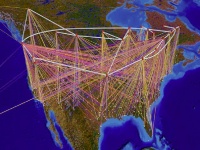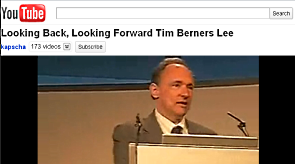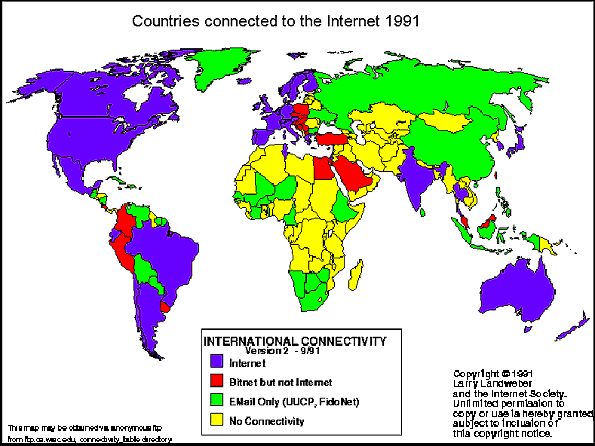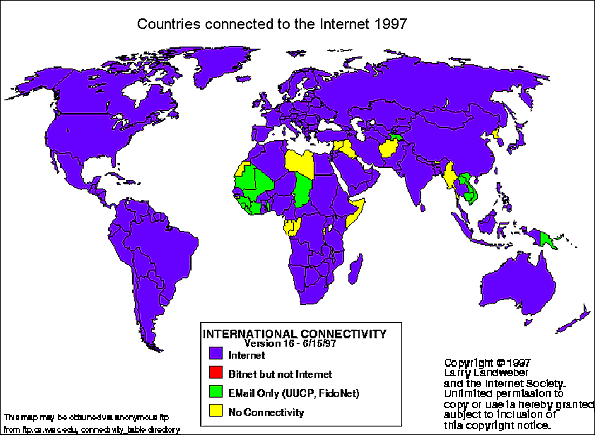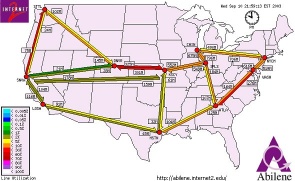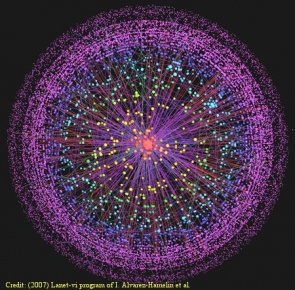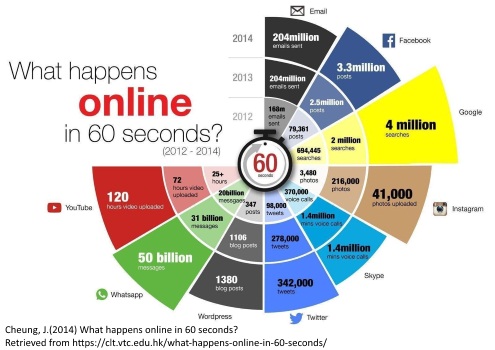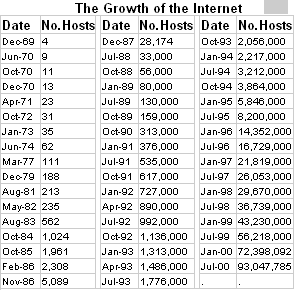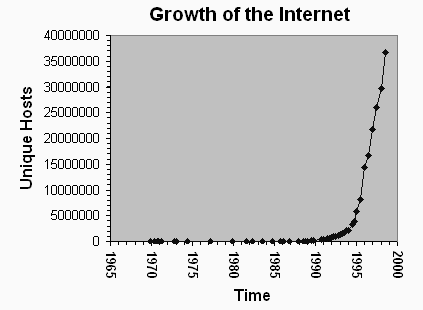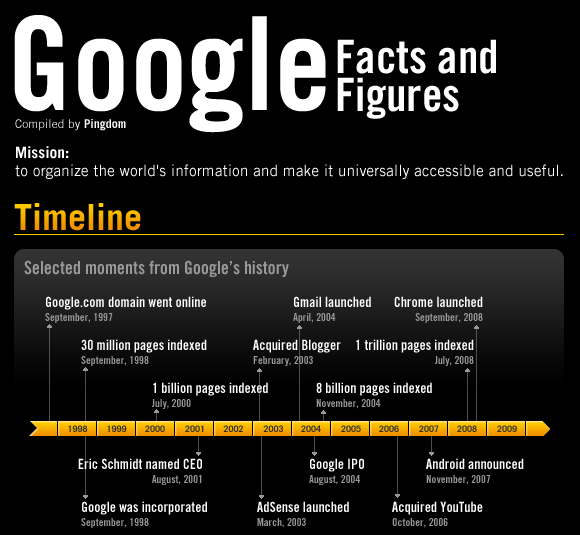VirtualMV/Internet and Web/History and Future
| Internet and Web | ||
|---|---|---|
| Theory | Introduction | What is HTML? | Client Server ecosystem | Glossary | History and Future | How the Internet works | Types of Website | Markup Languages | Interactive Websites | | |
| Web Tools | Web Browsers | Search Engines (SEO Optimization) | World Wide Web (Hypertext and Page) | Cookies | Email | Discussion Forums | FTP | (SSH, IRC) | |
| Technologies | Connecting | Broadband | Mobile | Web Conferencing | Intranets, Extranets, Tunneling | Gateway Servers | | |
| Issues | Security | Legal (Privacy, Confidentiality, Integrity) | Copyright and Fairdealing | Accessibility | Culture and Netiquette | | |
| Web Site Development | Planning ( Types | For Mobile) | Development (Design Components | Graphic Design) | Programming | Hosting | Marketing and Promotion | Advertising | Business Intelligence | Monitoring and Maintenance (Performance Tuning) | |
| Web Site Management | Roles | Management | User Expectations | Content Management | Site Maintenance | Policies and Guidelines | Promotion | Risk Management | |
Overview
By the end of this page you will be able to:
|
On Wikipedia
From W3C
History - Interactive infographics
Internet History: HTML Code Evolution 1.0 to 5.0 (INFOGRAPHIC) (Bartels, 2011)[1]
History of the Internet INFOGRAPHIC( Powers, N.d.)[2]
History of Search (Wordstream, 2010)[3]
The Evolution of the Web (Google, Hyperakt, Vizzuality, 2011)[4]
Videos
| History of the Internet (Bilgil, 2009)[5]
|
Future vision
| A Day Made of Glass... Made possible by Corning. |
Also to show advances in software: Miku 39 is a virtual Performer projected on a large glass screen performing with a live band, voice as well as image all computer generated. http://www.youtube.com/watch?v=-dd4HqNOA4U
Bibliography
- The History and Evolution of Social Media (Webdesigner Depot, 2009)[6]
- Sterling, Bruce. "Short History of the Internet". Retrieved from the World Web Web : http://w3.aces.uiuc.edu/AIM/scale/nethistory.html by Sci-Fi author is an excellent, easy to read, chatty introduction to the history of the Internet.
- A graphical timeline of the history of the Net. Retrieved from the World Wide Web : http://www.bbn.com/roles/researcher/timeline/ .
- Internet histories (2000), Internet society.Retrieved 24 July 2000 from the World Wide Web: http://www.isoc.org/internet/history/ . 02-Jun-2000. Internet history including documents from the original researchers.
- History of the Internet . Retrieved from the World Wide Web: http://www.northernwebs.com/bc/bc10.html
- Internet timeline. (2001) Genuity. Retrieved 28 Aug 2001 from the World Web Web : http://www.genuity.com/about/timeline/index.htm A graphical timeline of the history of the Net.
- Down to the Wire - The History of the Internet in NZ Down to the Wire
1960’s - The Cold War
The Internet has had a relatively brief history. It grew out of an experiment begun in the 1960’s by the U.S. Department of Defense’s Advanced Research Project Agency (ARPA). They wanted to create a computer network that would continue to function in the event of a disaster, such as a nuclear war. If part of the network were damaged or destroyed, the rest of the system still had to work. In 1962 Paul Baran of RAND Corporation published "On Distributed Communications Networks" which introduced Packet-switching (PS) networks; no single outage point. In this system packets of data are individually addressed and transferred from node to node, with none of the nodes being more important than any other.
1970’s -[71 ARPANET 4 Nodes, eMail, 75 ARPANET operational]
In 1969 a trial network, called ARPANET, was launched. To begin with there were 4 nodes or hosts, all super-computers at U.S. universities. Researchers at each institution could send data to each other and remotely control each other’s computers. Gradually through the early 70’s more hosts were added (see table 2.1.). In 1971 Ray Tomlinson developed email. In 1975 ARPANET had proved to be so successful that it was converted from an experimental network to an operational one.
Although ARPANET was supposed to be used for long-distance computer research, it quickly became apparent that most of the traffic was actually made up of messages sent from researcher to researcher. While many of the messages were notes about long distance networking, such as suggestions for improving the software and hardware of the network, they also included news, gossip and discussion about hobbies. From the beginning, the culture of the Internet, and the collaborative procedures for running it began to evolve.
ARPANET’s original standard for communication was known as Network Control Protocol or NCP. As more and more hosts were added through the 70’s, it became apparent that NCP would not be able to handle indefinite expansion. Researchers began to work out a new protocol that would allow billions of hosts to be added. This higher-level, more sophisticated standard was called TCP/IP.
By the late 70’s many other networks of computers had been created, all linked to ARPANET using the TCP/IP protocol. Around this time the whole thing began to be called the Internet.
1980’s - [83 MILNET, 85 NSF Net, 89 ARPANET retired]
In 1983 the original military segment of ARPANET broke away to form MILNET. One of the other networks was NSFNET, a series of networks for research and education communication created by the US National Science Foundation (NSF). In 1985, the NSF began to upgrade their national network – it was much faster than ARPANET so it took over the duty of the backbone of the Internet. At the same time, many regional networks were created to link individual institutions with the national backbone service. In 1989 ARPANET was finally retired.
1990 - [91:Berners-Lee Hypertext; 92: Veronica. 93:Mosaic, InterNIC]
The Internet grew rapidly in the late 80’s and early 90’s as people discovered its potential, and as new software applications were created to make access easier. In 1991 NSF lifted its ban on commercial traffic on its network and Corporations began to link their own networks to NSFNET.
In the early years of the Internet all navigation was by text-only computer commands, making it difficult for the non-programmer to understand. However in 1991 Tim Berners-Lee of CERN released the hypertext system, which allowed links to be made from page to page, and images to be included in pages. This system, called the World Wide Web really took off when the first easy to use browser, called Mosaic, was released by NSCA in 1993.
In 1993 the NSF set up a service called InterNIC, which registered all addresses on the Internet so that data could be routed to the right system.
| Looking Back, Looking Forward Tim Berners Lee |
1991 : Countries connected
Gradually commercial firms and other regional network providers took over the operation of the major Internet arteries from the NSF. Similarly Internet software was increasingly released by commercial firms, instead of as a result of collaboration by academics. As the WWW became more commercialised and easy to use, and as more multimedia applications became available, so its popularity exploded
- Mid 1990s - commercial use of the Internet grows
- 1994 - commercial users outnumber academic users by 2:1 (now 3 million hosts)
- 1994 - InterNIC starts charging for domains
- 1994 - Internet Service Providers (ISPs) become common allowing dial-up access
- 1994 - Netscape Navigator released
- 1995 - Microsoft Internet Explorer released
- 1995 - Sun Microsystems release Java
- Late 1990s - commercial and personal use of the Internet explodes
- 1997 - the Browser wars begin (now 25 million hosts)
- 1999 - ICANN formed - they stop monopoly on domain name registration
1996 [NZ Xtra]
- NZ: Xtra launches.
1997 [NZ: BankDirect]
- NZ: BankDirect, NZ first virtual bank launched
- NZ: Consumers Institute launches web site
Countries Connected ('97)
1998 [Google, NZ:Telecom trials broadband]
- Google launched in garage in California
- NZ: Woolworths grocery shopping online
- NZ: Telecom trials broadband
1999 [First Blog, Napster, NZ:TradeMe, Jetstream]
- NZ: Trademe.co.nz starts
- First Blog
- David Bowie first major label artist to sell a album online
- Napster peer-to-peer music sharing
- Blair witch project (movie) promoted on internet
- NZ: Telecom introduces Jetstream
2000
- Y2K updating systems and disaster recovery plans major focus.
- Stephen King publishes "Riding the Bullet" exclusively online.
- NZ: INL introduces http://www.stuff.co.nz
- Dot-com crash in the US
- NZ: xtra has 300,000 members
- largest growth in Latin America and SE Asia (now 60 million hosts)
2001
- NZ: Stock exchange goes online
- Apple iPod.
2002
- NZ: Maori nz domain established
- Xbox Live for online games
- NZ: Government web portal announced
2003
- NZ: NZ Qualifications Authority allows secondary students to view results online.
- Podcasting (sending audio files like lectures) takes off.
- MySpace launched
- Medical experts diagnose and treat children by live video conference with the first paediatric telemedicine service
Internet2, Abilene backbone and performance ('03)
Abilene is a 10-Gigabit-per-second national backbone supporting high-performance connectivity and Internet innovation within the U.S. research university community. The set of advanced services supported include IPv6 and multicast and Abilene’s leading-edge infrastructure supports applications such as Internet-based High Definition Television and remote control of distant telescopes. ( http://abilene.internet2.edu/ )
Comparison of speeds: Downloading the DVD Movie "The Matrix"
| Type | Speed |
| 56K Modem | 171 hours |
| ISDN | 74 hours |
| DSL/Cable | 25 hours |
| T1 | 6.4 hours |
| Internet2 | 30 seconds |
Source: Mike Wendland (2003)
2004
- NZ: Trademe holds 10 millionth auction
- Blogging goes mainstream
- NZ: Telecom T3G allows fast mobile Internet access.
- Facebook launched in February
2005
- NZ: More than 55% of NZ primary and secondary students connected to xtra broadband.
- NZ: Statistics NZ allow the national census to be completed online.
- 2005 Free Gigabyte space available gmail. (Hotmail, xtra follows)
geographical search engines
- The ability to type in an address anywhere in the world and get a satellite image.
- 2005 keyhole purchased by Google ( http://www.keyhole.com ) now Google earth.
Dial-up vs Broadband The OECD ranks countries by total broadband subscribers per 100 inhabitants. New Zealand's total base of 283,798 translates into 6.9 subscribers per 100. South Korea was again first, with 25.5 subscribers per 100 inhabitants. (Nowak, 2005, October 25)[7]
- xxx
2006
New Zealand
- NZ:Maddigan's quest becomes NZ first drama available online
- NZ: http://www.digiRAMA.co.nz allow fans to legally download music
- NZ: 3,200,000 users out of a population of 4,274,588 which makes a total of 74.9 % of the population are using the internet. http://www.internetworldstats.com/sp/nz.htm
- NZ: New Zealand government paid $43 million to meet the capital costs of the high-speed Kiwi Advanced Research and Education Network (Karen).Karen can transfer data between New Zealand institutions at speeds of 10 gigabits per second, and offers a 620Mbps link to the United States and a 155Mbps connection to Australia. By 2008 the network was currently running at an average of between 1% and 4% of capacity.
Miscellaneous
- Peer-to-peer Music and videos downloaded through http://www.limewire.com
- http://www.FIFAworldcup.com gets a record 4.2 billion page views during the soccer World Cup.
Personal spaces
- MySpace, BeBo, MSN Spaces, youTube
Broadband
- Telecom (NZ)forced unbundles the local loop. Broadband access for other internet providers frees up.
Online help files
- Help files now a combination of on CD plus web, and include Flash and video tutorials.
Mobile access
- With the introduction of third generation mobile technology (3G) surfing the web on a mobile device becomes feasible (although - depending on the plan - expensive e.g. New media reports student accumulates $1800 bill by using a mobile phone to clear emails, use messenger and use discussion forums).
Wikis
- A publicly available web site where the pages can be changed by visitors to the site. Wikipedia is an encyclopedia created using this technique.
2007
- Personal web spaces (MySpace, BeBo and Youtube). Copyright and privacy issues
- Online Auctions (Trademe, eBay) and low value transactions (Safetrader, Paypal). Also effects on "bricks and mortar" second hand businesses, and usage in work time (as auctions going 24/7).
- Google searches are being censored in China.
- Spread of residential broadband.
- Geographical mapping systems (Google earth and Microsofts virtual earth), are now being included in more an more applications.
- Microsoft's .net framework
- Apple releases the iPhone
Virtual
- Second life evolving into education
Mobile Technologies
New Zealand
- Xtra mail moves to Yahoo Bubble.
- Major migration problems with registration system.
Internet2
- The Internet2 consortium announced that its updated infrastructure is ready to go online and will launch with an initial capacity of 100 Gbps in dedicated chunks of 10 Gbps next January. The group demonstrated its new infrastructure during its Fall 2007 meeting, in which a third of a terabyte was transferred within five minutes over a 10 Gbps connection involving the University of Nebraska-Lincoln and Fermilab in Batavia, Ill. The optical improvements help to provide a "uniquely scalable platform on which to build side-by-side networks that serve different purposes, such as network research and telemedicine," according to the consortium. ..The network will continue to offer an advanced Internet Protocol network that supports IPv6, multicast, and other high-performance networking technologies. The consortium also has plans to develop new 40 Gbps and 100 Gbps technologies. (Gruener, 2007, Oct 9)[8]
2007 Japan has the world's fastest Internet connections
Japan has the world's fastest Internet connections, and delivers more data at a lower cost than anywhere else in the world. In fact, broadband service in Japan is between eight to 30 times faster than in the United States and much less expensive. Faster Internet speeds in Japan, South Korea, and much of Europe will lead to Internet innovations that are likely to remain unavailable in the United States for many years. The high Internet speeds in Japan allow Internet users to watch broadcast quality, full-screen television over the Internet while all most Americans can access are wallet-sized, grainy images. Other Internet applications in Japan currently unavailable to Americans include low-cost, high-definition teleconferencing, which has been used by doctors in urban areas to diagnose patients, and advanced telecommuting. Analysts say Japan's advancement is largely due to better wire and more aggressive government regulation. In 2000, the Japanese government compelled its large phone companies to share wires with startup Internet providers. As competition grew, the cost of broadband in Japan fell by about half and broadband speed increased 33-fold. In 1996, a similar measure to allow access to phone company lines was strongly endorsed by Congress, but federal support fell through in 2003 and 2004 when the Federal Communications Commission and a federal court ruled major companies do not have to share phone or fiber lines with competitors, and the Bush administration did not appeal the decision. "The Bush administration largely turned its back on the Internet, so we have just drifted downwards," says former U.S. diplomat to Japan Thomas Bleha. (Harden ,2007, August 29)[9]
2007 Internet map
The shape of the online universe. This image shows the hierarchical structure of the Internet, based on the connections between individual nodes (such as service providers). Three distinct regions are apparent: an inner core of highly connected nodes, an outer periphery of isolated networks, and a mantle-like mass of peer-connected nodes. The bigger the node, the more connections it has. Those nodes that are closest to the center are connected to more well-connected nodes than are those on the periphery.
Image Credit: Lanet-vi program of I. Alvarez-Hamelin et al. (Proceedings of the National Academy of Sciences)
Graham-Rowe, D. (2007, June 19) Mapping the Internet Routing traffic through peer-to-peer networks could stave off Internet congestion, according to a new study. Retrieved June 21, 2007 from http://www.technologyreview.com/Infotech/18944/
2008
Early 2008 Statistics NZ announced broadband subscribers had overtaken dial-up. To December 2007 there were 757,100 broadband subscribers and for every 100 people 18.3 had a broadband connection (the OECD average is 20 per 100) (Hoyle, 2008, May 21)[10].
- December: Google launches Chrome web browser
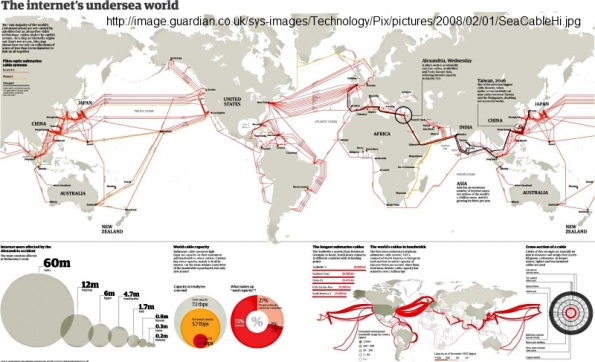
2009
- Huge growth in Social Networks (Twitter)
- Cloud Computing (e.g. Google Docs, Microsoft re-engineering the .net framework)
- Apple iPhone (Touch interfaces)
2010
- HTML 5
- Google Android
- Apple iPad
- Fragmentation of the internet?
- World Wide Web May Split Up Into Several Separate Networks
- The recent dispute between the Chinese government and Google, and the latter's subsequent threat to leave China, has some analysts worried that the World Wide Web may fracture into several regional fiefdoms. "A new information curtain is descending across much of the world," says U.S. Secretary of State Hillary Clinton. Analysts say that China wants to maintain control in shaping next-generation Internet standards, and note that it already has the tools to create and manage its own cyberspace. If Google leaves China for good, it could lead to a disintegration of the Internet into several regional or nationally sovereign clouds, says University of Toronto professor Ron Deibert. Several other countries have already isolated themselves from the global Internet by blocking Web sites. North Korea, Cuba, Iran, Saudi Arabia, the United Arab Emirates, Syria, Vietnam, Tunisia, and Bahrain are among the most isolated countries, according to a Harvard University-run Web site aimed at tracking Internet accessibility by country.(Krause, 2010)[11]
- World Wide Web May Split Up Into Several Separate Networks
- Five Billionth Device About to Plug Into Internet
- IMS Research estimates that there will be roughly 5 billion devices connected to the Internet by the end of August.
- That number is expected to grow to 22 billion by 2020, due to:
- forecasted 6 billion cell phones
- tablets, eBook readers, Internet TVs (2010 estimated 2.5 billion internet + normal TVs), cameras, digital picture frames, and a host of other networked consumer electronics devices
- increased machine-to-machine communications in applications such as smart electric grids, surveillance and public safety, and traffic and parking control.
- (Cox, 2010)[12])
2011
- June: Microsoft release Office 365 (Cloud based)
- July: Goggle+
So long dot.com
- The easy way to consult the Internet will soon be via "dot.anything".
- The Top-Level Domain program will be ratified by ICANN (Internet Corporation for Assigned Names and Numbers) in Singapore on June 20, followed by a four-month global communication campaign. After that will come a 60-day window to apply for a Top-Level Domain name, which will come at a cost of $US185,000 to discourage frivolous applications. (Hayes, 2011)[13]
The Internet in 60 seconds (2011)[14]
How The World Spends Its Time Online (visualeconomics, 2010)[15]
2012
- Google glasses (2.5 min) http://www.youtube.com/watch?v=JSnB06um5r4
- October Windows 8
- In NZ households(Harris, 2012, Nov 1)[16]
- 44% have smartphones (from 13% a year ago)
- 20% used a tablet
- 68% used their phone to access internet
2013
What Happens In An Internet Minute?
2014
Growth
The Internet is growing exponentially. It doubles in size every 18 months. The table below shows the growth of the Internet, measured in the number of hosts, i.e. the number of unique IP addresses registered.
Source: Hobbes’ Internet Timeline: http://www.isoc.org/zakon/Internet/History/HIT.html .
Internet growth in New Zealand 1999-2004
In the NZ Internet E-commerce Outlook report (IDC) Feb 2000, the number of Kiwis with internet access were estimated at
- Dec 1999: 861,000
- Dec 2000: 1.1 million
- Dec 2004: 1.9 million.
(Source: IDG ( http://www.idg.co.nz )
6 Predictions for the internet
6 Predictions about the internet
Six quirky Predictions about the internet, Would be interesting to see these come true.
History of the Australian Web (Graphical)
History of the Australian Web(n.d.)[18]
Comments for the page
Hey, the page looks a bit chaotic. But that doesn't hurt. You've certainly got me thinking. That tiki-toki tool is interesting. I keep thinking about how to displays parrallel evolutions.
I'd tend to ask students to do "their" version, after assembling a few more interesting perspectives. This one might be useful. http://en.wikipedia.org/wiki/Regional_Internet_registry It tends to break down the belief that the internet is some cohesive thing.
The "evolution of html" is obviously still too close to the top. Tim berners lee's proposal for the www being in 1990. http://www.w3.org/Proposal.html As he said ""I just had to take the hypertext idea and connect it to the Transmission Control Protocol and domain name system ideas and—ta- da!—the World Wide Web." http://en.wikipedia.org/wiki/Tim_Berners-Lee
So maybe some background on the history of hypertext may be an idea. This one's not real good. http://en.wikipedia.org/wiki/Hypertext
You might also want to bring "the internet" down to a local level and ask students, "so which network do we use to connect to the Internet in this classroom?". That should get a few brain cells twitching. (Just so you're a chapter ahead. It's http://www.karen.net.nz/ at your end)
Do us a favour. I'm not based anywhere. Been travelling for the past 18 months. Europe last year. Asia this. Thailand today. Please don't "consider a separate part for other countries". I spend most of my time trying to get NRENs to collaborate. They don't. They compare. That's why OERers end up having to cobble together tools like this google group, with a wiki (in our case). AsiaPac doesn't have an (active) association for NRENs. But the euo based one is not bad. http://www.terena.org/activities/media/
Government and education are the only two industries which can't adapt to a globalized world. They just can't get past their national borders. I won't rave on here as I want to start at wayne's critical point - ".. a ludicrous situation where taxpayers are frequently required to pay twice for their learning materials."
21/8/2011: Simonfj
(Looks like I really do have to rebuild this page!! - vmvadmin 20:04, 21 August 2011 (EDT) )
 References
References
- ↑ Bartels, A. (2011)Internet History: HTML Code Evolution 1.0 to 5.0 (INFOGRAPHIC)<. Retrieved from http://www.rackspace.com/cloud/blog/2011/05/03/internet-history-html-evolution/
- ↑ Powers, J (n.d.) History of the Internet. Retrieved from http://www.onlinemba.com/blog/internet-history/
- ↑ Wordstream (2010) Internet History of Search. Retrieved from http://www.wordstream.com/articles/internet-search-engines-history/
- ↑ Google, Hyperakt, Vizzuality (2011) The Evolution of the Web. Retrieved from http://evolutionofweb.appspot.com/
- ↑ (Bilgil, M.(2009). History of the Internet. Retrieved from http://vimeo.com/2696386
- ↑ Webdesigner Depot (2009) The History and Evolution of Social Media Retrieved from http://www.webdesignerdepot.com/2009/10/the-history-and-evolution-of-social-media/
- ↑ Nowak, P. (2005, October 25) Free calls mean less broadband – Telecom. Retrieved March 20, 2005 from http://www.nzherald.co.nz/section/story.cfm?c_id=5&ObjectID=10351794
- ↑ Gruener, W. (2007, Oct 9) 100 Gb/s Internet2 Completed. TG Daily Retrieved October 11, 2007 from http://www.tgdaily.com/content/view/34284/118/
- ↑ Harden, B. (2007, August 29) Japan's Warp-Speed Ride to Internet Future. Retrieved August 29, 2007 from http://www.washingtonpost.com/wp-dyn/content/article/2007/08/28/AR2007082801990.html Washington Post
- ↑ Hoyle, J. (2008, May 21) NZ broadband uptake raises OECD ranking. The Dominion Post, C1.
- ↑ Krause, R. (2010)World Wide Web May Split Up Into Several Separate Networks. Retrieved February 1, 2010 from http://www.investors.com/NewsAndAnalysis/Article.aspx?id=519041
- ↑ Cox, J. (2010). Five billionth device about to plug into Internet.Network World (08/16/10). Retrieved August 25, 2010 from http://www.networkworld.com/news/2010/081610-5billion-devices-internet.html
- ↑ Hayes, I., (2011, May 24) But how should I address you?. Retrieved from http://www.stuff.co.nz/technology/digital-living/5045907/But-how-shall-I-address-you
- ↑ The Internet in 60 seconds. (2011) Retrieved June 19, 2011 from http://www.digitalbuzzblog.com/infographic-60-seconds-of-statistics-on-the-internet/
- ↑ visualeconomics (2010) How The World Spends Its Time Online. Retrieved from http://www.visualeconomics.com/how-the-world-spends-its-time-online_2010-06-16/
- ↑ Harris, C (2012, Nov 1) Kiwis still behind in adopting new tech. Dominion Post. Retrieved from http://www.stuff.co.nz/dominion-post/business/technology/7893596/Kiwis-still-behind-in-adopting-new-tech
- ↑ Cheung, J.(2014) What happens online in 60 seconds? Retrieved from https://clt.vtc.edu.hk/what-happens-online-in-60-seconds/
- ↑ History of the Australian Web(n.d.). Retrieved August 7, 2009 from http://avant.interactionconsortium.com/australian_internet/#
|
virtualMV | Superquick wiki guide | Please give me some feedback |
VirtualMV/Internet and Web/History and Future. (2024). In WikiEducator/VirtualMV wiki. Retrieved December 22, 2024, from http:https://wikieducator.org/VirtualMV/Internet_and_Web/History_and_Future (zotero)
|


